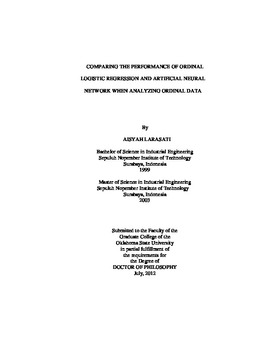| dc.contributor.advisor | DeYong, Camille F. | |
| dc.contributor.author | Larasati, Aisyah | |
| dc.date.accessioned | 2013-12-10T18:05:03Z | |
| dc.date.available | 2013-12-10T18:05:03Z | |
| dc.date.issued | 2012-07 | |
| dc.identifier.uri | https://hdl.handle.net/11244/7772 | |
| dc.description.abstract | Scope and Method of Study: The purpose of this study is to compare the performance of the Ordinal Logistic Regression (OLR) and Artificial Neural Network (ANN) models when analyzing ordinal data using different scenarios by varying the combinations of the marginal probability distributions and correlation coefficients. Two internal links in the Service Profit Chain (SPC), the relationship between employee perceived value of the internal and external determinants of employee satisfaction and employee overall satisfaction and the relationship between employee overall satisfaction and job performance are used as a framework to build the OLR and ANN models. Ordinal data collected from surveys at two training restaurants (Taylors' Dining at Oklahoma State University, USA and Fajar Teaching Restaurant at Universities Negeri Malang, Indonesia) and simulated correlated ordinal data are fitted to the OLR and ANN models in order to compare the mean of misclassification rates from each model. A model with a lower misclassification rate is preferred. | |
| dc.description.abstract | Findings and Conclusions: The application of the OLR and ANN models to analyze a causal relationship between one input variable and one output variable results in no statistically significant difference between the means of the misclassification rates resulting from both models for all three scenarios tested. On the other hand, the application of the OLR and ANN models to analyze a causal relationship between three input variables and one output variable results in a statistically significant difference between the means of the misclassification rates resulting from both models for all three scenarios tested. The OLR model outperforms the ANN model when it is used to analyze ordinal data that has similar marginal probabilities and correlation coefficients to Taylors' data. In contrast, the ANN model outperforms the OLR model when it is used to analyze ordinal data that has marginal probabilities and correlation coefficients either similar to FTR's data or randomly distributed. These results suggest that the complexity of the problem, which is represented by the number of input variables (attributes), and the complexity of the data structures, which is represented by the correlation coefficient and marginal probability distribution including the kurtosis, should be considered before fitting data sets to either the OLR or ANN models. | |
| dc.format | application/pdf | |
| dc.language | en_US | |
| dc.rights | Copyright is held by the author who has granted the Oklahoma State University Library the non-exclusive right to share this material in its institutional repository. Contact Digital Library Services at lib-dls@okstate.edu or 405-744-9161 for the permission policy on the use, reproduction or distribution of this material. | |
| dc.title | Comparing the performance of ordinal logistic regression and artificial neural network when analyzing ordinal data | |
| dc.contributor.committeeMember | Pratt, David B. | |
| dc.contributor.committeeMember | Kolarik, William J. | |
| dc.contributor.committeeMember | McCann, Melinda H. | |
| dc.contributor.committeeMember | Slevitch, Elisaveta Lisa | |
| osu.filename | Larasati_okstate_0664D_12243.pdf | |
| osu.accesstype | Open Access | |
| dc.type.genre | Dissertation | |
| dc.type.material | Text | |
| dc.subject.keywords | artificial neural network | |
| dc.subject.keywords | ordinal data | |
| dc.subject.keywords | ordinal logistic regression | |
| dc.subject.keywords | simulation | |
| thesis.degree.discipline | Industrial Engineering and Management | |
| thesis.degree.grantor | Oklahoma State University | |
